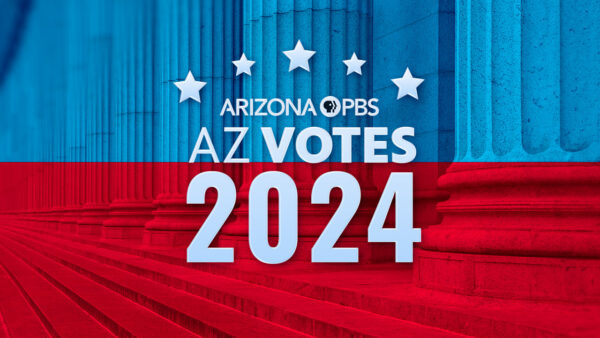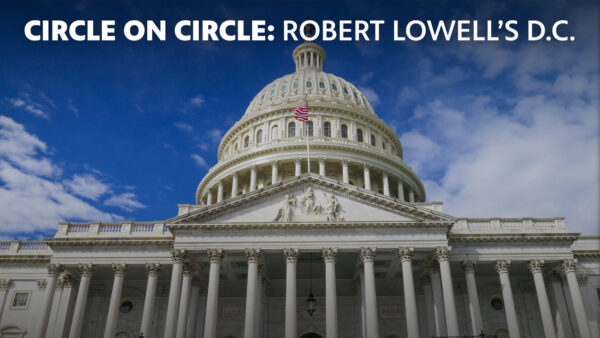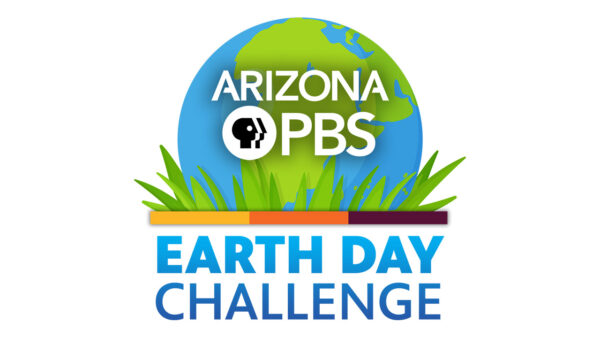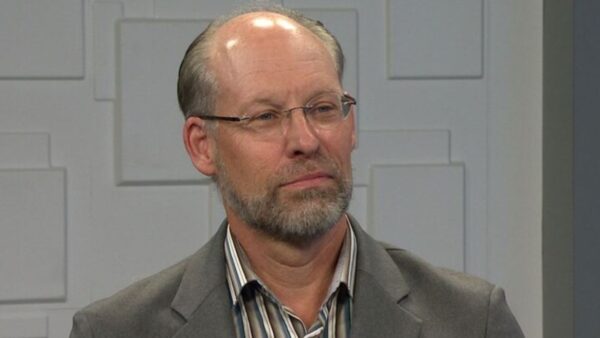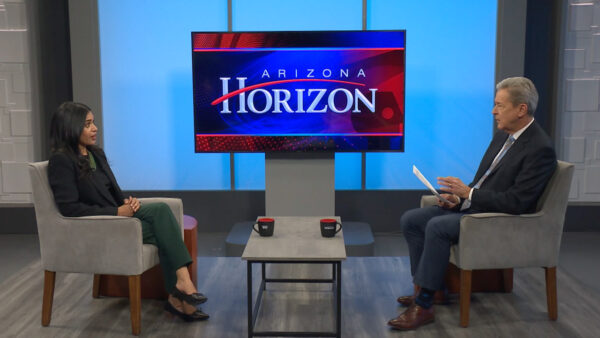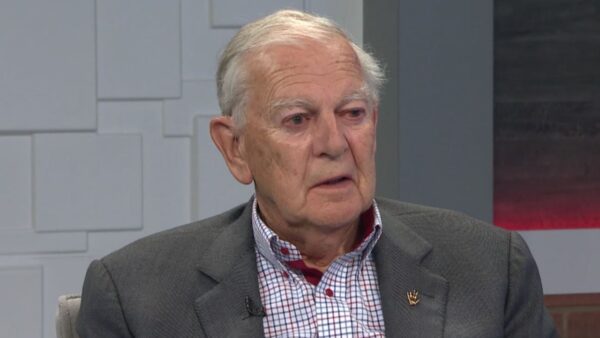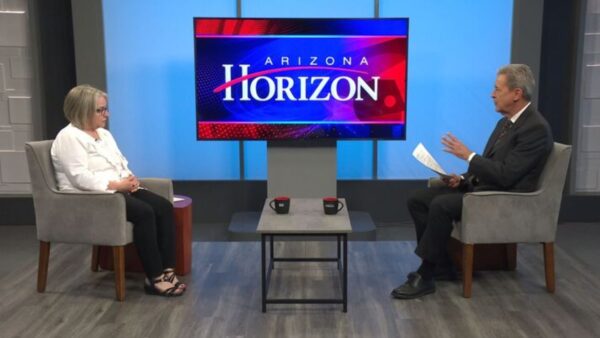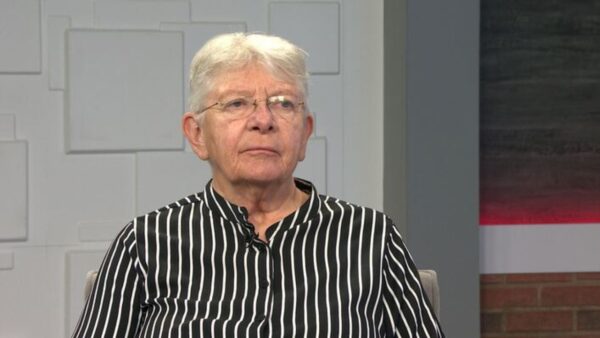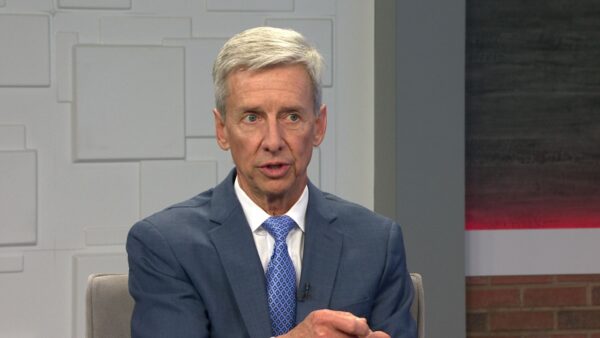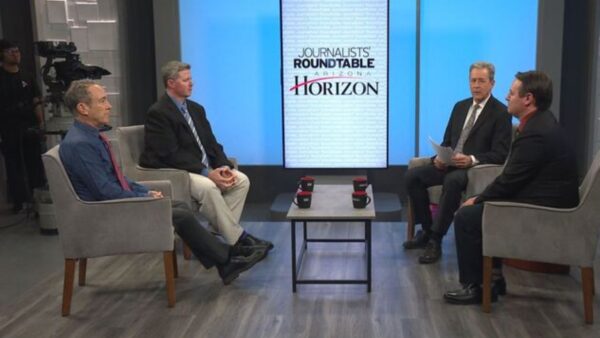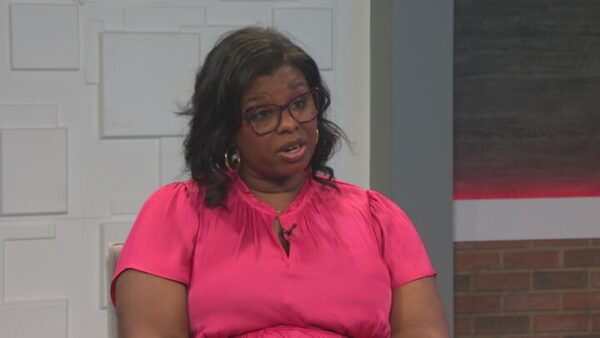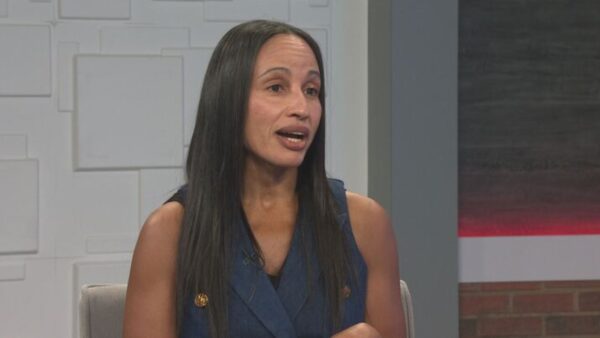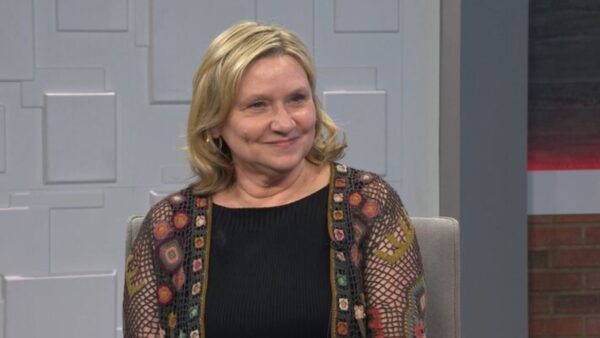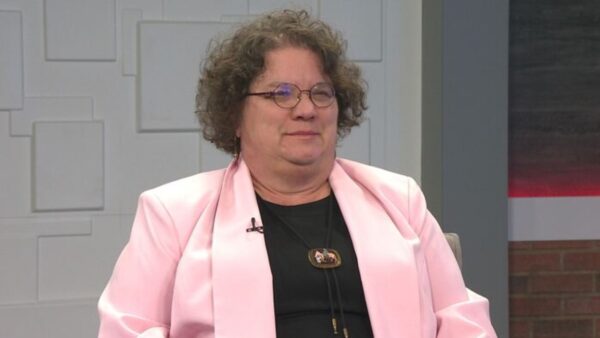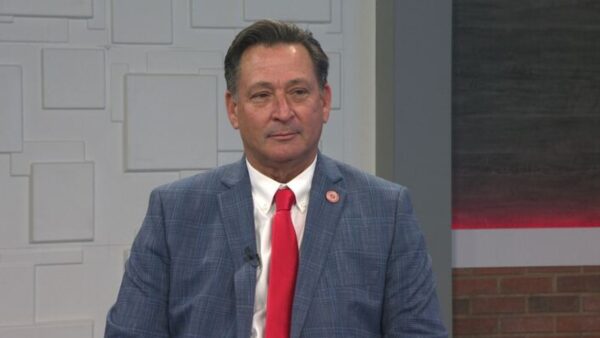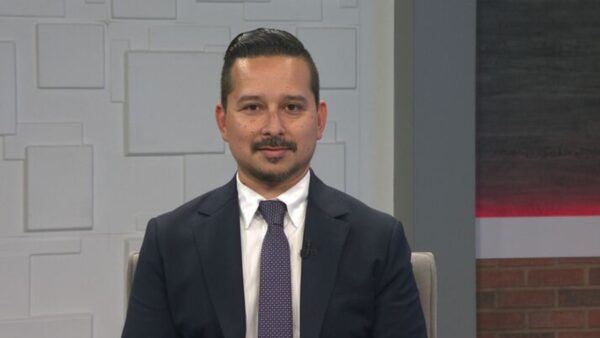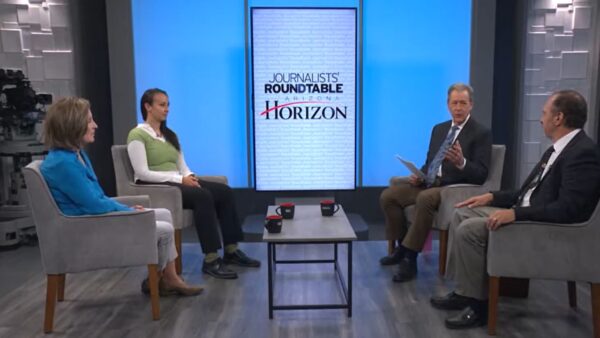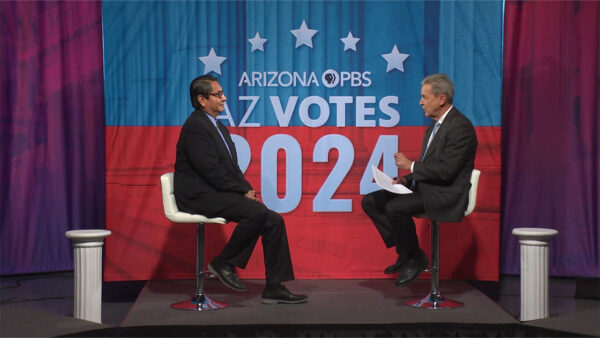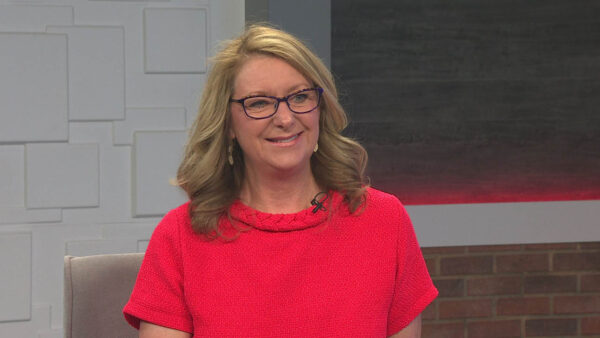Phoenix’s Proposition 104 would increase and extend a current tax to pay for expansion of light rail and other transportation projects. Randal O’Toole, a Cato Institute Senior Fellow, will speak against the measure, while Phoenix city councilwoman Kate Gallego will speak in favor of it.
TED SIMONS: Coming up next on "Arizona Horizon," we'll have a debate on a Phoenix ballot measure to expand light rail and other forms of transportation. And we'll hear from both sides on the idea of designating a new national monument near the Grand Canyon. Those stories next on "Arizona Horizon."
VIDEO: "Arizona Horizon" is made possible by contributions from the Friends of Eight, members of your Arizona PBS station. Thank you.
TED SIMONS: Good evening, and welcome to "Arizona Horizon," I'm Ted Simons. Arizona is tied with Alaska for the lowest college graduation rate in the country. That's according to a new report from the U.S. Department of Education which shows only %29 of Arizona students earn a four-year degree in six years or less. Arizona also had the highest student loan default rate, 18% compared to 11% nationwide. State officials know that the results are impacted by the significant number of students getting online degrees from Arizona-based for-profit universities. Indeed, while Arizona's public college completion rate of 57% was actually higher than the national average, for-profit universities showed a rate of just 23%. Phoenix voters will be deciding next month on prop 104, a measure that calls for expanding and increasing the sales tax for street improvements, along with expanding light rail and other forms of public transportation. Here now to debate the proposition is Phoenix City Councilmember Kate Gallego who supports prop 104, and Randal O'Toole, a Cato Institute senior fellow, who is against the measure. Good to have you both here, thanks so much to both of you for joining us.
KATE GALLEGO: Thank you.
RANDAL O'TOOLE: Thank you.
TED SIMONS: You support prop 104. Why?
KATE GALLEGO: Proposition 104 is a long-term transportation plan developed by citizen leaders, a committee headed by former secretary of transportation Mary Peters, who looked at all the needs we have in our City of Phoenix, our increasingly dense downtown, the growth in the northern and southern portions of our city. They recommended a comprehensive transportation plan that will be in front of the voters this August. So coming up soon, ballots should be mailing. It really is an investment in the future of our city. It grows out the bus grid so that everyone has a chance on arterial streets to take buses. Sixty-six% of the plan is buses. It also includes billions in investments in streets, which are key to economic development. Sometimes we have businesses come and say, but for the addition of a street, we would be in your community. So that will bring us jobs. It'll also help us triple the light rail.
TED SIMONS: You're opposed to this proposition, why?
RANDAL O'TOOLE: I'm opposed to the light rail. Everything this ballot measure calls for can be done without raising the sales tax. Just keeping the existing sales tax as it is. The money for streets, buses, money for improving bus service all can be done without raising the sales tax. The increase in the sales tax is necessary for light rail. And light rail is an obsolete, slow, low-capacity form of transit. You can carry twice as many people on buses than you can on light rail. You can move people more safely. Light rail kills three to four times as many people per passenger mile carried as buses do. You can move people for a lot less money. You can have better transit if you rely on buses than if you rely on light rail. So the city would be better off taking light-rail out and not increasing the tax, and the idea that money is going to go for streets that, depends on the light rail. If the light rail has cost overruns, the very little money in the proposition that goes for streets will end up being discarded.
TED SIMONS: Light rail seems to be a bugaboo for a lot of folks with this proposition, how do you respond?
KATE GALLEGO: It's actually the element we heard the most about. We did a general plan for the city, also on the ballot. The number one thing we heard throughout the city, not just in the parts that have light rail, was we want more connectivity. Please bring the light rail to our community. Citizens have seen the light rail, and the growth and development associated with it. They have seen the opportunity it brings for students to be able to get to the school of their choice. They are excited about it and have said, we want light rail to go west, south, north.
TED SIMONS: But the argument has been made that it's not as safe, it's too costly. You can do better with street improvements and increased bus service. If there's a better way, it's an obsolete system. How do you respond to that?
KATE GALLEGO: This is a plan that includes many different transportation options. But 20% of it is light rail, and what we've found is that it's a huge driver for economic growth. The number one question that our economic development director gets from companies who want to come into our community is what sites are available along light rail. We don't get that question, what sites are available on bus lines. The companies, especially knowledge companies, want to be on the light rail. They have told us that's why they are investing. That's true throughout our region including State Farm in Tempe.
TED SIMONS: Has light rail been bad for Phoenix?
RANDAL O'TOOLE: It's been bad for Phoenix transit riders after they opened the light rail. They had to raise bus fares by 40%, they reduced bus service by 18% and total transit ridership declined after the year light rail opened. Per capita transit ridership has declined by 9%. Per worker, transit ridership has declined by 18%. According to census data, most people in Phoenix who have jobs but don't have cars nevertheless get to work by car. Very few actually take transit to work. So light rail isn't working even for people who don't have cars.
TED SIMONS: It's not working you're saying. My question is has it been bad for Phoenix? Because a lot of folks think it's been good for Phoenix.
RANDAL O'TOOLE: I think that Valley Metro has greatly exaggerated the economic benefits from light rail. They have claimed a new high school was built along the light rail because of light rail. I just want to know, how is it that people in 1996 knew that a light rail was going to be built and started having more children so they had to build the high school along the light rail line. They claim the Convention Center was expanded because of the light rail, but the decision was made before the light rail was built, before the decision to build the light rail was made. So they simply counted everything that was built next to the light rail as something that was built because of the light rail and that's just not true.
TED SIMONS: Economic exaggerations, I'm hearing.
KATE GALLEGO: He talks a lot about education and schools along light rail. We do not have a public high school bus system in the Phoenix union district. They use the Valley Metro system, and they regularly get top grades for all of the money they are able to spend on classroom and school programs instead of transportation, because of this partnership. So 44% of our light rail riders are students. They are investing in their future. They are being able to get to Universities. ASU did tell us, they came downtown because of the light rail. They wanted many options for their students to be able to get between their campuses, and that this system is crucial to their success.
TED SIMONS: Are you against this light rail as it's designed, as it has so far been built, and as it looks like it's proposed to be expanded? Or are you against light rail, period?
RANDAL O'TOOLE: Light rail is an obsolete technology that makes no sense anywhere. The name light rail itself is deceptive. It sounds like it's lightweight. But in fact, according to the glossary of the American public transit association, light rail means low capacity transit. You can move twice as many people between Tempe and Phoenix with buses than you can with light rail per hour. A light rail car has a lot of people, can hold a lot of people, more than a bus. But you can only run one light rail train every three minutes and you can run buses much more frequently than that. You can end up moving more people. Since buses can move more people, do it faster and safer, and they can do it for a lot less money, according to the transportation plan the cost of building one new light rail line will be 150 times greater than starting one bus rapid transit line.
TED SIMONS: But we're hearing that there are folks who will invest either along the light rail line or invest in downtown Phoenix or even looking at Phoenix because of light rail. Is that an invalid argument?
RANDAL O'TOOLE: According to all the research that's been done, light rail does not increase economic growth. It might influence the location of that growth but the growth is going to take place with or without the light rail. Some of the fastest growing cities in America either have no light rail or they have almost no rail transit. Austin is the fastest growing city in America by percent. Almost no rail transit, one fiddley-dink line that doesn't work. Indianapolis is the fastest growing city in the U.S., no light rail. Columbus is second, no light rail. So light rail does not make cities grow faster. If anything, the high tax burden it imposes makes cities grow slower.
TED SIMONS: Indeed the tax burden is a factor in this particular vote and for the future of the light rail. Is it worth it?
KATE GALLEGO: We really think this is an investment in creating a global city. Minneapolis is a great city but we want to compete with cities like Chicago that are attracting corporate headquarters. You see so many cranes in their downtown. Their streets can't accommodate cars for all of those buildings, so they need multiple transportation options and that's what this plan gives us. It's rail, bus, bicycle, it's an investment in sidewalks for people who choose to walk.
TED SIMONS: And interesting you mentioned sidewalks. Because there are those who look at light rail in Phoenix and say the city itself, by virtue of the fact that for six months out of the year no one even wants to be on a sidewalk much less look at one or build one, everything is kind of far apart. The city wasn't designed for that kind of mass transit. How do you respond to that?
KATE GALLEGO: We're investing in a lot of policies to encourage shade trees and other items that will help make our sidewalks more comfortable throughout the year and support the light rail system. But we're also finding that people do use the system throughout the year, and that they are glad to have the option. I represent the area south of downtown. In that area 45% of people either have one car in their household or no cars. So this really is a great option. For some of the students in my district, they will about a get to more educational opportunities like Grand Canyon University, ASU West or be more connected to downtown. So it's giving them an educational opportunity. As you said at the top of the show, we do not have a college graduation rate that leads the nation.
TED SIMONS: Again, do you think that this building that we're in right now, the development we've seen along Central Avenue and in this downtown Phoenix corridor area along Roosevelt Row even, do you think all of that would have happened without light rail?
RANDAL O'TOOLE: I think it would have happened somewhere. It might not have happened in this particular location but it absolutely would have happened somewhere. The thing is, buses can move more people. You put free wi-fi on buses, offer a few amenities, comfortable seats, you can attract more riders than you can to a hot, crowded uncomfortable light rail where most people have to stand. There's not room for enough seats. So if you want to move lots of people between Tempe and Phoenix, if you want to move lots of people between Phoenix and Glendale, buses work a lot better. A good example was the 2014 Super Bowl where almost everybody had to arrive by mass transit. They had a choice between buses and trains and it took hours to empty out of Super Bowl for people riding the trains. The buses just filled up and took people away. The buses worked great, the trains failed.
TED SIMONS: Last word, the Super Bowl is touted by supporters as one of the reasons you should have light rail. He's saying the light rail performed pretty poorly.
KATE GALLEGO: We had a million people come to Super Bowl Central in downtown Phoenix during the Super Bowl. We could not have done it without the light rail. It was the busiest week on record. We hit our single-day maximum. Washington was shut down. Buses couldn't pass through the central core to the bus stations. But light rail was the workhorse getting people through the Super Bowl. We learned a lot from what happened in the 2014 Super Bowl. It turned out their backlog was of people purchasing tickets. We did a lot to make sure we had prepaid tickets, tickets available early and we had a wonderful success with moving people in and out of downtown with multiple different options.
TED SIMONS: Final word Again, you are opposed to light rail period, regardless of the success or failure it might show?
RANDAL O'TOOLE: It's an obsolete technology. I think buses would have been far more successful, they could have moved far more people for far less money.
TED SIMONS: Alright, we have to stop it right there. Thank you both very much, appreciate it.
KATE GALLEGO: Wonderful,thank you for having us.
RANDAL O'TOOLE: Thank you.
VIDEO: Expand your horizon with the Arizona Horizon website. To get there go to azpbs.org, click on the Arizona horizon tab at the top of the screen. Once there, you can access many features to help you make a more informed viewer. Watch interviews by clicking on the video button or scroll down to the bottom of the page for the most recent segments. You can also find out what's on "Arizona Horizon" for the coming week. If you would like an RSS feed, pod cast or want to buy a video, that's all on the website, too. Want to learn about specific topics like immigration or the legislature? You can visit our special web sessions. There's also a page for educators. Show your support for "Arizona Horizon" at azpbs.org/Arizonahorizon.
Randal O'Toole:Cato Institute Senior Fellow;Kate Gallego:Phoenix City Councilwoman
